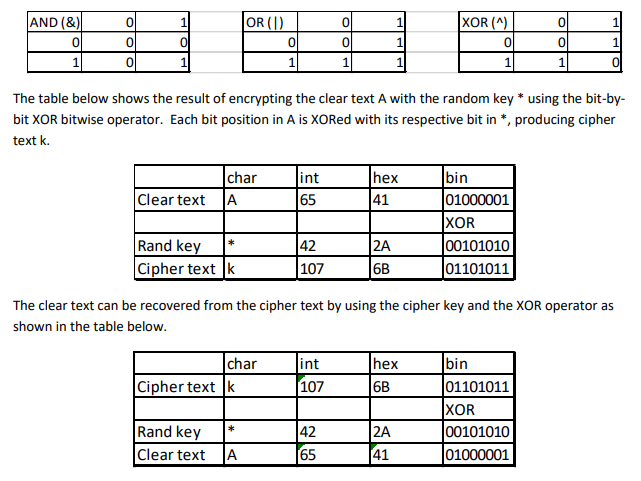Question
Part 2: One Time Pad Encryption (60 points) One Time Pad (OTP) encryption, when implemented properly, cannot be hacked by cryptanalysis. This method uses the
Part 2: One Time Pad Encryption (60 points)
One Time Pad (OTP) encryption, when implemented properly, cannot be hacked by cryptanalysis. This method uses the clear text (message to be encrypted), a random key of characters (the same size of the clear text) and the exclusive OR (XOR) operator. The table below contains the truth tables for bitwise operators. These operators work bit-by-bit on C data.

This project will require the use of the read_file() and write_file() from Part 1 and the following functions:
1. main function with a menu including 3 choices: encrypt file, decrypt file and exit program.
2. make_rand_key(length of key, key) generates a fixed length string of random chars.
3. encrypt(clear file, key file, cipher file) generates a random key using make_rand_key(), perform the clear text XOR ket text, byte-by-byte, to produce the cipher text string and write both the random key and cipher text strings to file.
4. decrypt(key file, cipher file, clear file) uses the cipher text XOR random key to recover the original clear text and writes the clear text to a file (make sure to use a different file name than the original file so you can compare the results).
Modify the read_file() and write_file() functions to also accept an integer argument representing a fixed number of bytes to be read or written. This is to specify the number of bytes to be read from the cipher file, which may contain the EOF character, or write to the cipher text file, which may contain null chars. This is necessary because the cipher may contain both EOF and \0 characters. This will be explained further below. Sample function calls to read_file() and write_file():
1. read_file(0, clear_file); // Read in a file with of unknown length, getting the length from the file read. clear_file is a string containing the path to the clear text file. This function returns a char array created with memory allocation.
2. read_file(len, clear_file); // Where len > zero, reads len chars from a file. clear_file is a string containing the path to the clear text file. This function returns a char array created with memory allocation.
3. write_file(0, key, key_file); // Writes a string to file until the \0 char is reached. key is the string of random chars and key_file is a string containing the path of the text file.
4. write_file(len, cipher, cipher_file); // Where len > zero, writes len chars to a file. cipher is the cipher string of chars and cipher_file is a string containing the path of the text file.
The menu in main() should look like:
Encrypt a file: 1
Decrypt a file: 2
Exit: 3
Enter a choice:
I suggest using a loop in main to show the menu, get a choice from the user and a switch statement to execute the chosen function. For the first two choices, the necessary file names should be read by main() and passed to encrypt() and decrypt(). To generate the random key, the length of the key and a char array pointer are passed to make_rand_key(). After make_rand_key() completes, the char array contains the randomly selected chars. When the user chooses to exit the program by entering 3, the loop should exit.
The make_rand_key() accepts the length of the random key char array and a pointer to this array. This function uses the srand(time(NULL)) function to seed the rand() function and the rand() function to get random chars. The rand() function accepts no argument and returns an integer value between 0 and RAND_MAX (32,767 on most Intel-based computers). The return from rand must be scaled between 0 and 255 and explicitly castes as a char before being added to the char array. The EOF (integer value of - 1) must not be selected as one of the chars in the array so it can be read back from a file during the decrypt operation. If EOF is detected as a random char, subtract 1 from the value to make it -2. It may also be a good idea to replace any null (integer value 0). This may interfere with writing to file and should be replaced with 1. A sample function call to make_rand_key is: make_rand_key(len, key); // Where len > zero, generates and returns a random key of len chars
The encrypt() function accepts the clear text, random key and cipher text file names as arguments. It reads the clear text files, generates a random key, performs XOR on clear text and random key, producing the cipher text, and writes the cipher text to file. When using malloc(), make sure to add 1 to the length of the string for the null char. Also, make sure to free() any allocated memory before the function returns. Sample function call for encrypt(): encrypt(clear_file, key_file, cipher_file); // Where the three arguments are strings containing filenames
The decrypt() function accepts the random key, cipher text and cipher text file names as arguments. It reads the random key and cipher text files. Read the random key first using read_file and either getc (in a loop) or fgets to read the cipher text file due to the possibility of a stray EOF in the cipher file. Sample function for decrypt(): decrypt(key_file, cipher_file, message_file); // Where the three arguments are strings containing filenames.
Note: You must check if memory is successfully allocated and that files are opened successfully before using pointers to these objects. If a memory allocation or file open is unsuccessful, the pointer will be NULL. If a NULL pointer is found, you should provide an appropriate error message and terminate the program. You can test that the open file check works by passing a filename that does not exist.
0 0 XOR (A 0 0 0 OR (I AND (&) 0 0 0 0 The table below shows the result of encrypting the clear text A with the random key *using the bit-by- bit XOR bitwise operator. Each bit position in A is XORed with its respective bit in *, producing cipher text k. bin 01000001 XOR 00101010 01101011 hex 41 char int Clear text A 65 42 Rand key* Cipher text [k 107 6B The clear text can be recovered from the cipher text by using the cipher key and the XOR operator as shown in the table below bin 01101011 XOR 00101010 hex 6B char int 107 Cipher text k Rand key 42 Clear text A 65 41 0 0 XOR (A 0 0 0 OR (I AND (&) 0 0 0 0 The table below shows the result of encrypting the clear text A with the random key *using the bit-by- bit XOR bitwise operator. Each bit position in A is XORed with its respective bit in *, producing cipher text k. bin 01000001 XOR 00101010 01101011 hex 41 char int Clear text A 65 42 Rand key* Cipher text [k 107 6B The clear text can be recovered from the cipher text by using the cipher key and the XOR operator as shown in the table below bin 01101011 XOR 00101010 hex 6B char int 107 Cipher text k Rand key 42 Clear text A 65 41Step by Step Solution
There are 3 Steps involved in it
Step: 1

Get Instant Access to Expert-Tailored Solutions
See step-by-step solutions with expert insights and AI powered tools for academic success
Step: 2

Step: 3

Ace Your Homework with AI
Get the answers you need in no time with our AI-driven, step-by-step assistance
Get Started


